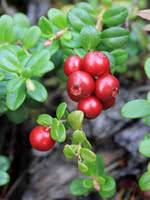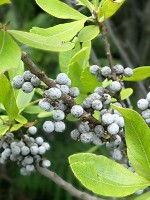Mon-Fri 9am - 5pm Mountain time
Bog Cranberry (Lingonberry) vs Northern Bayberry
Vaccinium vitis-idaea
Myrica pensylvanica
NOT AVAILABLE THIS SEASON - MIGHT RETURN
NOT AVAILABLE THIS SEASON - MIGHT RETURN
Bog Cranberry is a native, ground cover species. These plants generally produce one crop per year in summer. Plants may spread 3 feet in width forming a dense mat which makes it attractive as an ornamental ground cover.
Wild crops of Bog Cranberry are harvested each year in Newfoundland (more than 200,000 lbs/yr). Harvest of wild fruit can no longer keep up with demand. In Europe, 80 million pounds per year of this crop is grown or harvested from the wild.
Bog Cranberry flowers are similar in shape to those of blueberry and may be white or pink in color. These berries are considered to be highly flavored but not as tart as cranberries.
Check out our YouTube video of this plant in the fall: Fall Bog Cranberry.
Note: We use Bog Cranberry for Vaccinium vitis-idaea. This species is also known by many other common names. Please confirm the scientific name to ensure you are ordering the correct plant.
Northern Bayberry makes an excellent hedge or feature shrub. It will retain its leaves in warmer climates but drops them in colder areas. They produce blue-grey berries that have a wax coating on them that can be used to make candles or soaps.
In colder hardiness zones the leaves turn an attractive orange to red colour in the fall, making it a striking addition to your landscape.
Northern Bayberry is native to Nova Scotia and tolerates both drought and wet conditions. It is also a nitrogen fixer that tolerates poor soil conditions.
Bog Cranberry (Lingonberry) Quick Facts
Northern Bayberry Quick Facts
Toxicity: Warning: The wax from bayberry fruit is considered toxic and may be carcinogenic.

